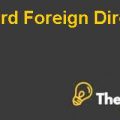Introduction:
Richard Rothschild is still stuck with the problem of managing the foreign currency risk, as he is not satisfied with the use of either forward contract or money market hedge in order to hedge against the risk of Pound depreciating against the dollar. In the previous transaction, he is not able to earn a profit margin of 6% on the contract due to the use of these techniques. These techniques could only hedge against the downside risk however; it would not enable the organization to get any upside potential.
Therefore, in order allow for any upside potential along with the hedging of downside risk, he consulted John Gun for recommending any sort of other hedging strategy that would provide both the benefits.
Analysis:
Option Hedge:
Rothschild is in the verge of finding an effective solution for hedging against the foreign exchange risk while taking account of any upside potential, he is suggested by John Gunn to use an option hedging contract against the receipt of $ 1,057,500, which is an amount from a new sales contract with one of the companies in United Kingdom. The option hedge would allow the organization to receive the amount at a fix rate in the future date however; it would not create any sort of obligation, as it would be freely allowed to exercise the option of receiving the amount at that fix rate or otherwise it could lapse the contract by not exercising it. This option not only hedge against the downside risk but also enables it to gain any upside potential.
Hence, in order to carry out this hedge the organization needs to use the put contract, which would allow it to sell the currency receipt in Pound at a fix exchange rate between pound and dollar.
The month of March placed a strike price of 145 at 4.40 cents, which should be chosen for hedging against the risk.
The number of placed contract should be 85 based on the calculations in appendices.
Option vs Forward contract:
According to the appendices, the organization could receive the total amount of $ 1,486,845 using the option contract after deducting the premium of $ 46,530. In comparison to that, the forward contract would enable it to receive $ 1,501,439. This shows that the forward is a much better hedging technique as compared to the option hedging however; the option hedging require the payment of premium which reduces its attractiveness, but such premium is required for the necessary provision of flexibility allowed in the contract, which would enable the organization to gain any upside potential.
Hence, the organization is better off using forward contract if the currency rate between pound and dollar is depreciating though; the option contract is more valuable if the same currency rate is appreciating.
Overall, it would be much better to use an option contract in order to cover any downside risk along with an opportunity to exploit any upside potential.
Situation in 1985:
If the situation in 1985 is reviewed, then it would have been much better to use option contract, which would have allowed the organization to hedge against the downside risk of foreign exchange exposure while having a chance to gain any upside potential......................................
This is just a sample partial case solution. Please place the order on the website to order your own originally done case solution.
Surcharge for business UV2138 «Hide
by Schorr, Leslie Zanetti Source: Darden School of Business 5 pages. Publication Date: March 28, 1991. Prod. #: UV2140-PDF-ENG












